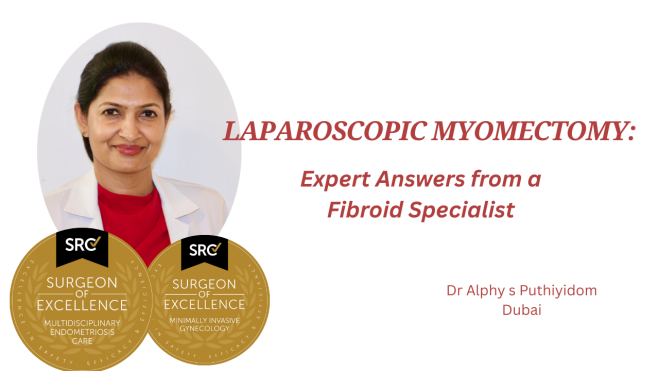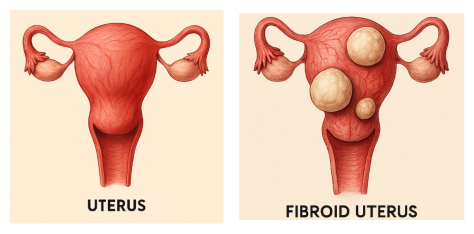
Learn from a fibroid specialist about laparoscopic myomectomy — a minimally invasive fibroid removal surgery that preserves fertility. Includes recovery tips, risks, and pregnancy outcomes.
As a surgeon performing laparoscopic myomectomy almost every week, I meet many women who have been told that hysterectomy is their only option for fibroid treatment. The truth is, in many cases, fibroids can be removed without removing the uterus — and with a minimally invasive approach, recovery is faster, and scarring is minimal.
This article answers the most searched questions about myomectomy and explains why laparoscopic or robotic fibroid surgery my preferred method is often.


A myomectomy is a surgical procedure to remove uterine fibroids (non-cancerous tumors of the uterus) while preserving the uterus. Unlike hysterectomy, you will still have your menstrual cycles and can become pregnant if desired.
A laparoscopic or robotic myomectomy is a type of minimally invasive myomectomy performed through a few small “keyhole” incisions. Compared to open surgery, it offers:
Smaller scars and less visible marks
Quicker recovery (2–3 weeks vs. 6–8 weeks)
Less postoperative pain
Shorter hospital stay — often just 1–2 days
It’s an excellent option for women who want a faster return to work and daily activities, while keeping their uterus.
You might need fibroid removal surgery if you have:
Heavy menstrual bleeding from fibroids leading to anemia
Pelvic pain, bloating, or pressure
Infertility or repeated miscarriages
Fibroids distorting the uterine cavity
Rapidly growing fibroids or those causing urinary/bowel symptoms
Laparoscopic / Robotic Myomectomy – Minimally invasive, faster recovery, less scarring.
Abdominal (Open) Myomectomy – Required for very large or numerous fibroids.
Hysteroscopic Myomectomy – For fibroids inside the uterine cavity; performed without abdominal incisions.
In my practice, the steps are:
General anesthesia for patient comfort.
3–4 small abdominal incisions – usually three 5 mm incisions and one 1.2 cm incision. The exact placement may vary between surgeons.
Laparoscope insertion to visualize the uterus
Blood loss reduction techniques, such as injecting medication into the uterus before fibroid removal.
Careful dissectionof fibroids from healthy uterine muscle.
Uterine reconstructionwith strong, layered stitches to ensure structural integrity and future pregnancy safety.
Contained in-bag morcellationto safely remove fibroid tissue without spreading cells into the abdominal cavity.
It’s an excellent option for women who want a faster return to work and daily activities, while keeping their uterus.
Yes — in experienced hands, laparoscopic or robotic myomectomy is very safe. Risks, which also apply to open myomectomy, include:
Bleeding (rarely requiring transfusion)
Internal scar tissue (adhesions)
Recurrence of fibroids over time
Uterine rupture in future pregnancy (rare; risk depends on fibroid size and location — C-section is sometimes advised)
Day 1–2 – Walking, light activities, home rest
Week 1 – Return to desk work possible for many women
Weeks 2–3 – Resume most normal activities
3–6 months – Safe time to start trying for pregnancy (depends on fibroid size/location)
Many of my patients conceive naturally after myomectomy for fibroids. If the fibroid removed was large or deeply embedded, I often recommend planned cesarean delivery to protect the uterine scar during labor.
Yes — fibroid recurrence is possible (15–40%). The risk depends on:
Age at the time of surgery
Number of fibroids removed
Hormonal factors
Regular pelvic check-ups and imaging help detect any recurrence early.
| Treatment | Preserves Uterus | Fertility-Friendly | Recovery Time | Recurrence Risk |
|---|---|---|---|---|
| Laparoscopic / Robotic Myomectomy | 2–3 weeks | Possible | ||
| Open Myomectomy | (slightly lower) | 6–8 weeks | Possible | |
| Hysterectomy | 6–8 weeks | None | ||
| UFE (Uterine Fibroid Embolization) | 1–2 weeks | Possible | ||
| Radiofrequency Ablation | Unknown | 1 week | Possible |
A: Most laparoscopic myomectomies take 1–3 hours, depending on fibroid size and number.
A: Pain is usually mild to moderate and managed with oral medication.
A: Yes — that’s exactly what a myomectomy does.
A: For suitable cases, yes — recovery is faster, scars are smaller, and postoperative discomfort is reduced.
If you’ve been diagnosed with fibroids and wish to keep your uterus, laparoscopic or robotic myomectomyoften offers the best balance between effective fibroid removal and quick recovery.
MBBS, MD(Obs&Gn),FMIS(Laparoscopy)
Head of Department, Obstetrics & Gynecology
Director, Center of Excellence – Minimally Invasive Gynecology Surgery
Director, Center of Excellence – Multidisciplinary Endometriosis Care
Advanced Gynecological Laparoscopic & Pelvic Reconstructive Surgeon
Mediclinic Welcare Hospital
Al Garhoud, Dubai
Mediclinic Parkview Hospital
Umm Suqeim, Al Barsha South 3, Dubai
Appointments 800-1999
www.mediclinic.ae
